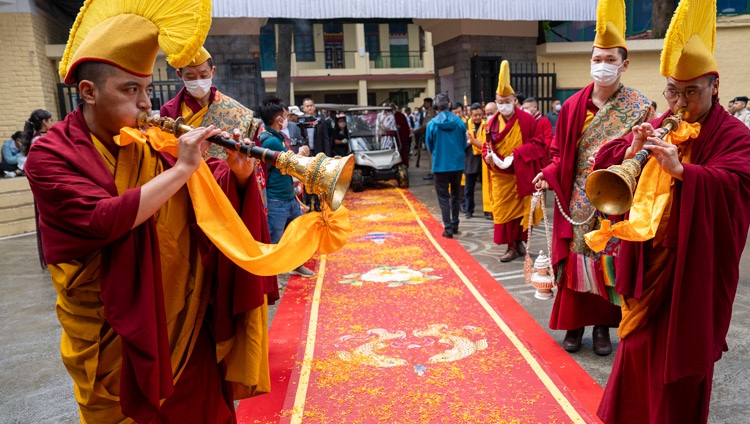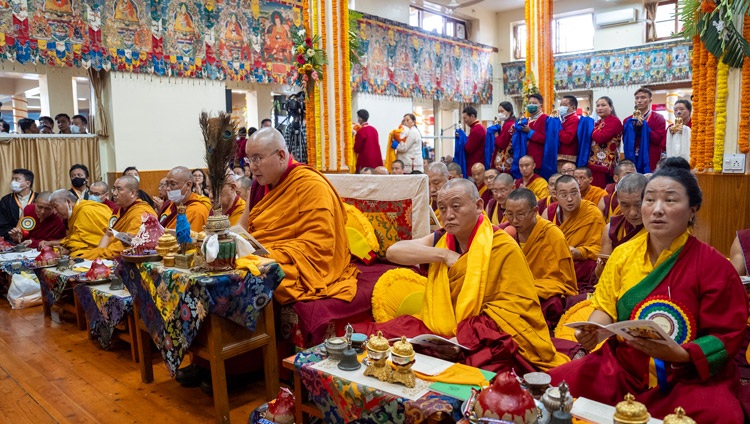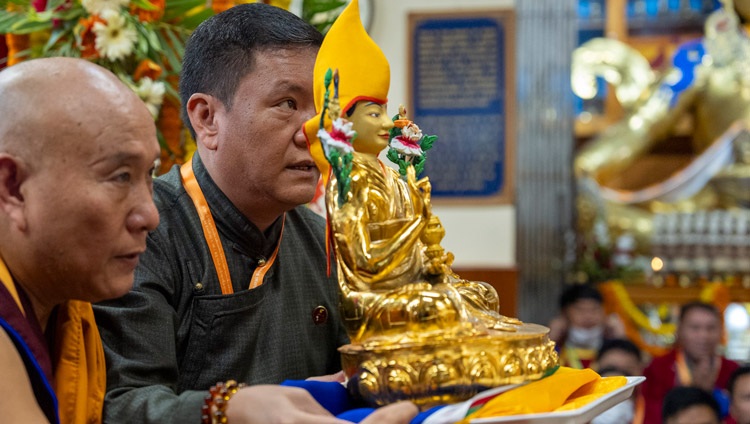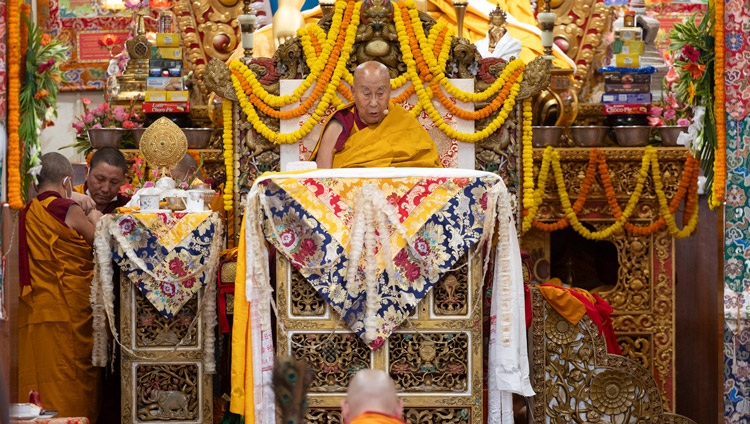Thekchen Chöling, Dharamsala, HP, India - The Tsuglagkhang, the Main Tibetan Temple, was brightly decorated today as part of a ceremony to pray for the Long Life of His Holiness the Dalai Lama. The pillars were wrapped in cloth in the colours of the Indian flag and hung with garlands of marigolds. The path through the courtyard was covered with red carpet embellished with coloured auspicious symbols. Immediately before His Holiness was about to arrive it was strewn with marigold petals.

When His Holiness reached the gate in a golf cart, Arunachal Pradesh Chief Minister Pema Khandu stepped forward to greet him and offered a golden silk scarf. He and other Mönpas, people from Tawang District of Arunachal Pradesh, the organizers of yesterday’s teaching and today’s long-life ceremony then escorted His Holiness to the temple. As the golf cart approached the lift on the eastern side of the temple a Mönpa laywoman and layman offered the traditional Chema Changpu as a mark of welcome.
As he walked to the temple door, His Holiness smiled and waved to well-wishers, stopping to accept a scarf from a small boy. Inside the temple he came to the front of the platform to salute the congregation. He then took his seat on the throne. To his right sat representatives of the Mönpa community and to his left were present and former officials of the Central Tibetan Administration.
Chief Minister Pema Khandu was accompanied by his wife and children, Arunachal MP Tapir Gao, Education Minister Shri Pasang Dorje Sona, MLAs from Lungla, Tawang, Kalatang and Dirang, as well as the Chairman of DoKA – the Department of Karmik and Adhyatmik Affairs. The 1400 Mönpas His Holiness has met over the last three days were joined in and around the temple by 3500 local Tibetans and other interested people.
Ling Rinpoché, who presided over the ceremony, sat directly in front of His Holiness. To his right was Namgyal Lobpön Lobsang Dhargyey and to his left Guru Tulku Rinpoché, former Abbot of Tawang Monastery, and Khandro Tsering Ché-nga. With them were several Mönpa Abbots.

The ceremony that was conducted today was based on a ritual composed by the Great Fifth Dalai Lama called ‘Granting the Pure Essence of Immortality’. While a praise of His Holiness that he had himself written at the behest of Dilgo Khyentsé Rinpoché was recited, Ling Rinpoché made a mandala offering and offered representations of the body, speech and mind of enlightenment.
A procession of Mönpa people in traditional costume bearing a variety of offerings began to pass through the temple. Ling Rinpoché gave His Holiness nectar and pills of longevity and the long-life arrow. He then presented him with trays bearing the eight auspicious symbols, seven royal emblems and eight auspicious substances.
During the recitation of the prayer for His Holiness’s long life by his two tutors, Chief Minister Pema Khandu offered him a statue of Jé Tsongkhapa. His Holiness was offered ‘tsog’. Representatives of the Mönpa community came before the throne to pay their respects. Among them was a young boy called Lhagyala Rinpoché.

His Holiness addressed the congregation. “Since we’re all gathered here for this Long-Life Ceremony, I’m going to give a transmission of a Guru Yoga practice called ‘Stairway to the Potala’. It begins, ‘Homage to Lokeshvara, Lord of the Universe’ and continues, ‘On my crown, upon a seat of lotus and moon, sits my root teacher, who is inseparable from Supreme Noble Avalokiteshvara, the Lord of the World, with one face and four hands — the first two folded in prayer while the two remaining hands hold a crystal rosary and the stem of a white lotus in full bloom’. He is the embodiment of all refuges.
“All of us here are practitioners of Avalokiteshvara,” His Holiness announced, “Let’s recite the six-syllable mantra together.” For several minutes the temple hummed to the chanting of Om mani padme hung.
His Holiness then completed the transmission and read the colophon at the end which described how he came to compose it while he was still in Tibet. ‘Having been requested, with the offering of a mandala, to compose a new Guru Yoga text that would be easy to practice for farmers living in villages and people who are illiterate, who need to learn it by heart from those who help by reciting it for them, this ‘Extremely Short Guru Yoga of Avalokiteshvara’ was written by the Buddhist monk Ngawang Lobsang Tenzin Gyatso, an upholder of the Buddha’s Teaching at the Palace of Good Fortune (Kalsang Phodrang) in Norbulingka (Tibet).’

“Since we left Tibet and came into exile I’ve been able to serve people extensively around the world from India. This Long-Life Ceremony has been organized by the Mönpas. These were the people who came to greet me and showed deep respect, when I left Tibet many of them touching their heads to my feet. Mönyul is where I entered India and, as I say, I was very moved by the devotion of the people.
”Today you have organized this ceremony for which I thank you. I pray that Avalokiteshvara will bless you and fulfil all your short and long-term goals. That’s all.”
The Chant-master recited various expressions of auspiciousness and the Prayer of the Words of Truth. The following verse made a fitting dedication:
May I never be separated from my perfect Guru throughout my lives
May I reach the state of Vajradhara
May the sublime precious bodhichitta grow where it has not grown
And where it has grown may it not decline but increase.
His Holiness left the temple, and, as he walked to the lift, stopped here and there to greet members of the crowd. Down in the courtyard he again waved to well-wishers before boarding the golf cart that carried him home to his residence,












